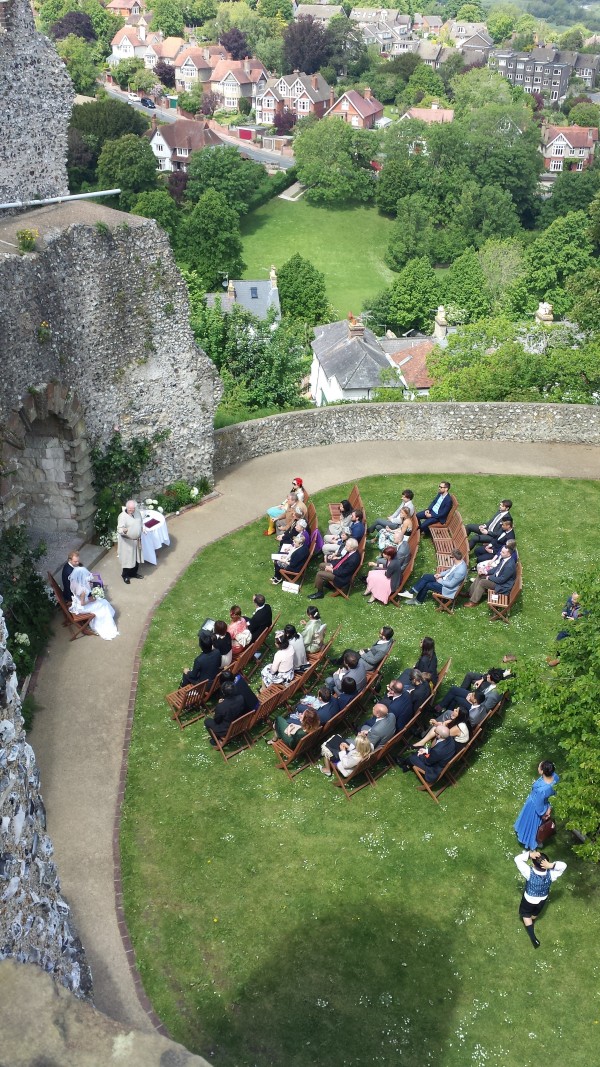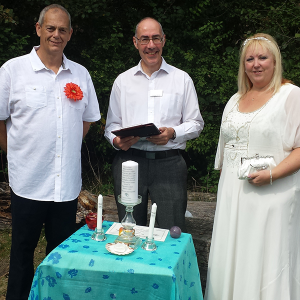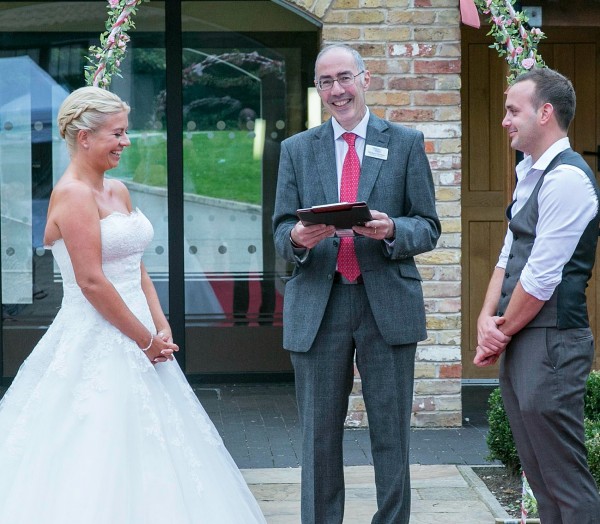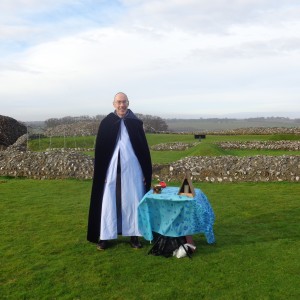by Michael | Aug 19, 2015 | Blog
Most people are familiar with the line that we have two ears but only one mouth because we ought to be listening twice as much as we speak.
Well, you might wonder how that applies in my job, as the popular image of a civil celebrant is that person standing up at the front, conducting the ceremony – be it a wedding, funeral, handfasting, blessing, naming or whatever – and jabbering away. In other words, I do the speaking and you (have to) do the listening!
However, there is another part of the proceedings that you probably wouldn’t think about, and that is when the ears/mouth equation comes into its own for me. That is during my planning meeting with the client.
After the initial contact, I almost always visit the next-of-kin, if it’s a funeral, or, if it’s a celebration, arrange a face-to-face or Skype meeting with the couple. As well as being an opportunity to see if we’re both OK to work together, this is a chance for the client to ask questions in an unintimidating atmosphere. For me, it is also an opportunity to ask questions and also to suggest ideas. (Yes, that does involve more talking!)
However, in reality, most of this conversation for me will be spent listening (although there is the occasional case – usually caused by shock after a death – when the client will say next to nothing, and I have to work at gaining their trust). I need to pay close attention, as I often have to pick up clues about what the client wants, as they may not really have much of a conscious idea themselves.
If the client does know exactly what they are looking for, my role is to take note so I can mould it in the best possible, most effective, way. I may question an element or two (“do you realise that …?”), but it’s not my job to change anything (provided everything’s legal, etc.).
I respect their wishes – they can have a mixture of religious elements (or none, if they choose) – and I try to accommodate any preferences they may have for readings, music and participants.
If they don’t know what they want, then I ask questions to get a sense for the sort of thing they may like and provide suggestions for possible rituals to fit the bill. When I finish, I try and put this all together to construct a meaningful and memorable ceremony that meets the needs – and beliefs – of the client. So maybe I do still sometimes talk a bit more than I listen, but I hope I’m getting the balance right.
Another way I’d love to put “two ears, one mouth” into practice is to respond to any requests you may have for subjects for me to deal with in my blogs. To quote my hero, Frasier Crane, “I’m listening!”

by Michael | Aug 11, 2015 | Blog
Where to have your wedding? The location is obviously one of the first things that couples want to arrange. For one thing, the more popular venues may be booked up a year or more in advance. Secondly, the atmosphere of the wedding can largely be dictated by the sort of venue chosen, so it’s not a decision to be taken lightly.
First considerations
Obvious things to consider are your budget. How much money do you want to devote to this? If you choose a less usual date or time of day, you may be able to secure the venue at a better price. Obviously, you will need estimates, possibly from several venues, before you commit.
The size of the venue is clearly important – you don’t want the wedding party engulfed in a huge area, but you certainly don’t want to be squashed together for the ceremony or reception. A preliminary visit, together with the events planner, is essential. Be prepared to ask lots of questions and be absolutely clear what the price actually includes.
Would you be intimidated by a castle setting, say, or do you want to push the boat out and go up the Shard or hire a Stately Home? Would something more homely suit?
And go with your gut. Is this a place where you feel you can be really happy?
Logistics
The next question is: are you going to want to have your reception at the same location as your ceremony? If not, you’ll need to think about the logistics. Will the party drive from the wedding venue to the reception? What about non-drivers? How long should you allow for this? Will your reception be spoilt, if it takes longer than you think to reach the venue? Is parking going to be an issue?
Unconventional Ceremonies
Naturally, the type of wedding you want will also dictate where you have it. If you are planning a handfasting wedding, then you’re probably going to have it in a field or at an Iron Age fort, for example. You’ll need to get permission from the landowner and you’ll have to decide what sort of reception you hold, if any – and where.
If you want a secular wedding, then the registrars have to be involved for the legal bit. If you want them to come out to a location of your choosing, it will have to have solid walls, for example (ie a marquee won’t do). So do your homework here.
If you don’t want a full religious service (eg church, synagogue, etc) but you want more than the routine register office ceremony, you can have the best of all worlds with a civil celebrant-led ceremony. Then you can have the service that you want in the location of your choice.

Civil Celebrant limitations
I am often asked what limits my availability, as regards location. Well, I can’t conduct a service in a C of E church, but that’s about it. Any other location – from hotels and restaurants to the Stonehenge inner circle, to a mountain top, a canalside, a back garden or underwater ( think creative!) – all these are technically available for wedding ceremonies.
Personal availablity
I live in Harrow, so I tend to work mostly in London, Herts. and Bucks., but I have conducted other ceremonies in Salisbury, Andover, Worthing , Epsom and the like. I guess that I haven’t been further afield because travel expenses inflate the fee. However, I was invited to conduct a wedding blessing in Ibiza last year – unfortunately, to my great regret, I had a clash of dates.
If you’re not planning to have your celebration in the South of England, don’t let it deter you from asking me for a quote. I’d love to help make your big day really special, wherever you choose. I can be surprisingly flexible!

by Michael | Jul 28, 2015 | Blog
Who’d have an outdoor ceremony? Especially in the UK!
In the past few weeks of so-called summer, London has enjoyed (if that’s the right word!) temperatures in the high 30s and also spells of torrential showers with maximum temperatures below 20 degrees. I guess I’m rather relieved that I didn’t have an outdoor ceremony to conduct in that period!
So does that mean that you shouldn’t even consider an al fresco ceremony?
The weather cannot be predicted in the UK – or virtually anywhere else, for that matter. (Let’s ignore the Atacama Desert, etc., for the purposes of this article.) So outside is always going to be a gamble. Is that a reason not to hold such a ceremony, then?
Advantages
- One reason to hold a ceremony outdoors is that you can save money. You still have to get permission and pay the appropriate fee (unless you’re using a back garden), but this may well cost less than booking a hotel or restaurant.
- You may have a particular attachment to a certain place – maybe you first met or got engaged there. One Vow Renewal I led took place beside a canal for the simple reason that the couple were canalboat addicts.
- If it all comes together, there is a wonderful, unique atmosphere about being outside, especially if the setting is special.

Precautions
Things can go wrong (indoors as well as out), but the main thing to prepare for when outdoors is the weather.
Every venue is different, but if you have a courtyard, say, with a portico, then that offers guests refuge from rain or strong sun. Job done! However, you will still have to consider protection for yourselves and the celebrant in the event of extreme conditions.
The bride will have to consider her footwear, if there’s heavy rain about, and her train, if she has one. Wind can play havoc with her hair, veil and dress.
Parasols or golf umbrellas may be worth investing in, if people are likely to be in exposed places for long. And if you actually get a hot and sunny day, then arrange for water to be available for guests and also for yourselves and your celebrant.
Finally, if the weather is likely to be really cold, then invest in some blankets, at least for older people.
One of the other things you will have to take into account is sound projection. Are you going to need a PA system? How big a ceremony is it likely to be? If you need a sound system, your civil celebrant or possibly whoever is providing music for later may be able to supply one, but you’ll have to investigate.
Some of the most enjoyable ceremonies I have officiated at have been outdoors, but I have not appreciated reading from my script beneath pouring rain! And as for being pursued by an aggressive wasp during the ceremony …!
by Michael | Jul 21, 2015 | Blog
People tend to enjoy creative ceremonies, even if they are sometimes a little suspicious of the unorthodox. Such rituals can help to differentiate the service from any other wedding and they can be meaningful, beautiful, spiritual and special.
I’d like to suggest four such ceremonies. As well as the rituals themselves, success depends on the explanation the civil celebrant offers in each case and also his/her manner and words.
1. Loving Cup
The couple can either combine white and red wine into one glass or goblet (or quaich) and drink from the resultant blush or simply drink the same beverage from the same glass. Of course, it doesn’t have to be wine.
Naturally, this represents the new unity of the couple
2. Unity Sand or Unity Candle
Another way of representing the two lives becoming one is a Unity ceremony.
The couple pour sand of different colour together into a container, so the colours merge. If the couple have young children, they could also be involved here, and their participation will symbolise unification of the families.
The Unity Candle works similarly. The couple light a taper each and then, together, the main candle. The mothers – or even children – could take part in this too..
3. Love Letter
Before the wedding, the couple write love letters to each other, which they will seal in an envelope.
During the wedding, they place their favourite drink or memorabilia along with the letters in a wine box. They seal the box and vow not to open it until the anniversary of their choice.
There is one exception: if their relationship becomes strained, then they can unseal the chest, consume the drink and read the letters. This should remind them why they fell in love and chose to be together in the first place.
4. First kiss, last kiss
Who gave each child their first kiss on earth? Their mother. Now the mothers can be invited up to give their child their last kiss as single people and thereby bless the union.
Your civil celebrant will have ideas for other ceremonies, but these four should give you a flavour of how your service can stand out. When people look back on your wedding, they will remember an unusual and beautiful ritual more than anything.
So will you.

by Michael | Jul 7, 2015 | Blog
I do appreciate that not everyone understands what I offer. Although there have been civil celebrants in this country for more than fifteen years to my knowledge, there is still widespread ignorance about our role and the benefits that we can provide.
To clarify things, I’d like to focus on three ceremonies I created and performed in the not-too-distant past. I’d like to think that these will shed light on what is on offer and even give you some food for thought.
Handfasting
Imagine holding an open-air wedding ceremony on an Iron Age hill-top fort!
That’s what Annie and Ross organised. They were an interesting pairing: she was pagan and he was half-Jewish. They asked me to put together a ceremony that would reflect both religions. A challenge I enjoyed rising to!
As soon as they had done the legal bit in Salisbury Register Office they, and their entourage, headed up the hill to where I, in my robes, and my table was awaiting them.

After a welcome, explanations were offered before each ritual.
The Jewish part involved the bride circling the groom seven times while he read out certain traditional statements (in English) about a “woman of valour”. He also broke a glass underfoot at the end to the traditional cries of “Mazal tov!”.
The pagan parts included charging the circle, summoning the elements of nature, drawing down the God and Goddess, reciting handfasting vows, and drinking from the Loving Cup.
A very special occasion.
Canalside Vow Renewal
Another happy outdoor ceremony took place at Basingstoke Canal Centre.
C. and S. were celebrating 25 years of marriage and had invited friends and family to their beloved canalside location. It was hot and humid – indeed, it cannot be claimed that we remained totally dry, but nobody minded.

We convened in a grove with benches arranged in a semi-circle. I brought a table and unity candle and off we went. One highlight was the personal celebrant address, which touched on some of the events – happy and a few sad – over the thirty years the couple had known each other. Some favourite songs were played. A simple, cheerful, yet moving ceremony was the outcome.
Wedding Blessing
A completely different setting was the prestigious British Medical Association House in the heart of London. The couple had requested the legal ceremony (with the registrars) before my turn came to bless them. In contrast to the formality of the first part, this was more relaxed and although some beautiful, memorable words were spoken, smiles and even laughter were an integral part of the proceedings (even before the wine in the Loving Cup was shared!) and all went away to the reception more than satisfied with the formalities.
I hope this gives a flavour of the variety of ceremony that a Civil Celebrant can offer. I would certainly be happy to answer any questions this article may give rise to.





